|
|
 |
|
Cyclopoida ( Order ) |
|
|
|
Corycaeidae ( Family ) |
|
|
|
Corycaeus ( Genus ) |
|
|
|
Ditrichocorycaeus ( Sub-Genus ) |
|
|
| |
Corycaeus (Ditrichocorycaeus) brehmi Steuer, 1910 (F,M) | |
| | | | | | | Syn.: | Corycaeus germanus : Claus, 1863 (p.156);
Ditrichocorycaeus brehmi : Boxshall & Halsey, 2004 (p.495); Valdés & al., 2007 (p.104: tab.1); Cabal & al., 2008 (289, Table 1); Vidjak & Bojanic, 2009 (p.433, Table II, IV, V); Vives & Shmeleva, 2010 (p.214, figs.F,M, Rem.); Isari & al., 2011 (p.51, Table 2, abundance vs distribution); Vidjak & al., 2012 (p.243, Rem.: p.254);
Corycaeus brehmi : Avancini & al., 2006 (p.143, Pl. 111, figs.F,M, Rem.); | | | | Ref.: | | | M. Dahl, 1912 (p.59, figs.F,M); Pesta, 1920 (p.646, fig.F); Gurney, 1927 (p.164, figs.F,M, Rem.); Rose, 1933 a (p.333, figs.F,M); Sewell, 1948 (p.441); Vilela, 1968 (p.39, figs.F,M); Razouls, 1972 (p.96, Annexe: p.136, figs.F,M); 1974 c (1975) (p.92, figs.F,M); Lakkis & Zeidane, 1987 (p.20, figs.F,M, Rem.) | 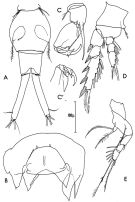 issued from : C. Razouls in Vie Milieu, 1974, 24 (1.A). [p.112, Fig.14]. Female (from W Medit.: Banyuls, France): A, 5th thoracic segment and abdominal segments (dorsal); B, last thoracic segments (dorsal); C-C', A2; D, P3; E, P4.
|
 issued from : C. Razouls in Vie Milieu, 1974, 24 (1.A). [p.113, Fig.15]. Male: A, urosome (dorsal); B-B', A2; C, Mxp; D, P1; E, P3; F, P2; G, P4.
|
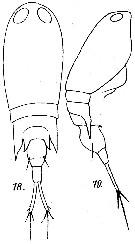 issued from : M. Dahl in Ergebnisse der Plankton-Expedition der Humboldt-Stiftung. Bd II, G. f1. I. Die Corycaeinen 1912. [Taf.IX, Figs.18, 19]. Female: 18, habitus (dorsal); 19, idem (lateral right side).
|
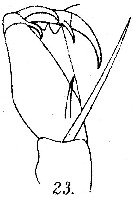 issued from : M. Dahl in Ergebnisse der Plankton-Expedition der Humboldt-Stiftung. Bd II, G. f1. I. Die Corycaeinen 1912. [Taf.IX, Fig.23]. Female: 23, A2.
|
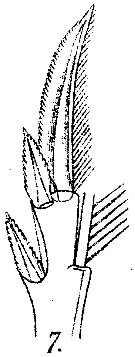 issued from : M. Dahl in Ergebnisse der Plankton-Expedition der Humboldt-Stiftung. Bd II, G. f1. I. Die Corycaeinen 1912. [Taf.IX, Fig.7]. Female: 7, terminal part of exopod of P2.
|
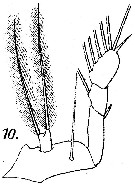 issued from : M. Dahl in Ergebnisse der Plankton-Expedition der Humboldt-Stiftung. Bd II, G. f1. I. Die Corycaeinen 1912. [Taf.IX, Fig.10]. Female: 10, P4.
|
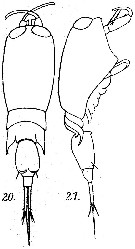 issued from : M. Dahl in Ergebnisse der Plankton-Expedition der Humboldt-Stiftung. Bd II, G. f1. I. Die Corycaeinen 1912. [Taf.IX, Figs.20, 21]. Male: 20, habitus (dorsal); 21, idem (lateral right side).
|
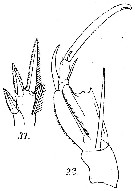 issued from : M. Dahl in Ergebnisse der Plankton-Expedition der Humboldt-Stiftung. Bd II, G. f1. I. Die Corycaeinen 1912. [Taf.IX, Figs.22, 31]. Male: 22, A2; 31, terminal part of exopod of P1
|
 [B & H] Female: Caudal rami at most as long as longer thangenital double-somite. Anal somite over 1.5 times as long as wide. Outer margin of 1st segment of A2 with 2 teeth. Male: Caudal rami at most 60 % as long as genital somite. [V & S] Female: Posterior points of thoracic segment 3, in dorsal view), reaching half genital segment. Basipodite 2 of P4 with the two setae parallel. Male: Posterior points of thoracic segment 3 longer than 1/3 genital segment. Process (tooth) of genital segment, in lateral view, downward. Basipodite 2 of A2 with distally in outer distal margin 1 tooth very salient. Terminal hook as long as basipodite 2.
|
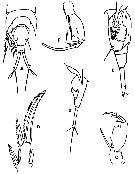 Issued from : R. Gurney in Trans. zool. Soc. London, 1927, 22. [p.164, Fig.25]. Female (from outer harbour at Port Said): A, last thoracic segments and abdomen (dorsal); B, same (lateral); C, A2; D, exopodite 3 of P2. Male: E, abdomen (lateral); F, A2. Nota male: - Eyes rather more widely separated. - 2nd somiiter has a slight wing-like expansion (as figured by Steuer for the female). - Median ventral hook of genital somite large (whereas Dahl describes it as small). - Margin of 2nd segment of A2 may have either a single large tooth or one large tooth with a small point distal it (Dahl describes a small two-pointed tooth distal to the large tooth). In the case of female the differences are rather greater: total length 0.81-0.94 mm Furca, anal and genital somites: 27-32 : 12-16 : 29-33, respectively. The furcal rami may be more than twice as long as the anal somite, whereas Dahl says that they are twice or les than twice its length. The longest seta of the furca is considerably longer than the furca, whereas it is about the same length in C. brehmi. In the P2, the terminal spine of the 3dr exopodal segment is greatly curved and the serrated outer marginal membrane is continued towards the inner margin near the tip, so that in some views a slight serration, is visible on the inner margin (this point is not mentioned by Dahl)
| | | | | Compl. Ref.: | | | Massuti Alzamora, 1942 (p.107, Rem.); V.N. Greze, 1963 a (tabl.2); Duran, 1963 (p.26); Mazza, 1966 (p.74); 1967 (p.367); Ehrhardt, 1967 (p.743, geographic distribution, Rem.); Deevey, 1971 (p.224); Apostolopoulou, 1972 (p.329, 386); Vives & al., 1975 (tab.II); Deevey & Brooks, 1977 (p.156, tab.2, Station "S"); Vives, 1982 (p.296); Kovalev & Shmeleva, 1982 (p.86); Scotto di Carlo & al., 1984 (p.1042); Regner, 1985 (p.11, Rem.: p.43); Jansa, 1985 (p.108, Tabl.I, II, III, IV, V); Brinton & al., 1986 (p.228, Table 1); Lozano Soldevilla & al., 1988 (p.61); Hajderi, 1995 (p.542); Hure & Krsinic, 1998 (p.91, 105); Suarez-Morales & Gasca, 1998 a (p.112); Siokou-Frangou, 1999 (p.479); Seridji & Hafferssas, 2000 (tab.1); Vukanic, 2003 (p.139, tab.1); Vukanic & Vukanic, 2004 (p.9, tab. 3); Isari & al., 2006 (p.241, tab.II); Zervoudaki & al., 2006 (p.149, Table I); Morales-Ramirez & Suarez-Morales, 2008 (p.524); Licandro & Icardi, 2009 (p.17, Table 4); Brugnano & al., 2010 (p.312, Table 2); Hafferssas & Seridji, 2010 (p.353, Table 2); Hafferssas & al., 2010 (p.1281, Table III, abundance vs spatial distribution); Mazzocchi & Di Capua, 2010 (p.428); Lidvanov & al., 2013 (p.290, Table 2, % composition); Pansera & al., 2014 (p.221, Table 2, abundance); Benedetti & al., 2016 (p.159, Table I, fig.1, functional characters) | | | | NZ: | 6 | | |
|
Distribution map of Corycaeus (Ditrichocorycaeus) brehmi by geographical zones
|
| | | | | | | Loc: | | | off Morocco-Mauritania, Canary Is., off Madeira, Lisboa, Sargasso Sea, off Bermuda (Station "S"), Iberian Shelf, Ibero-moroccan Bay, Medit. (Alboran Sea, Baleares, Banyuls, Ligurian Sea, Tyrrhenian Sea, Lake Faro (Sicily), Adriatic Sea, Island of Pag, Ionian Sea, Aegean Sea,, Thracian Sea, Marmara Sea, Lebanon Basin), Port Said, Suez Canal, Gulf of California (in Brinton & al., 1986; Jimenez-Perez & Lara-Lara, 1988), W Costa Rica | | | | N: | 53 | | | | Lg.: | | | (178) M: 0,81-0,76; (327) F: 1,16-1,02; M: 0,97-0,87; (449) F: 1,1-0,95; M: 0,84; (666) F: 1,1-0,95; M: 0,84; (670) F: 0,89-0,7; M: 1,04-0,92; (920) F: 0,92; {F: 0,70-1,16; M: 0,76-1,04} | | | | Rem.: | Overall depth Range in Sargasso Sea: 0-500 m (Deevey & Brooks, 1977, Station "S");
For Boxshall & Halsey (2004, p.491) the subgenus (Dahl, 1912) is considered as full generic status pending phylogenetic revision of the whole family at the generic level.
After Regner (1985, p.43) this species was found in slightly more than half the samples in the coastal area of middle Adriatic (Dalmatian coast) and the number of individuals was gradually reduced going offshore.
| | | Last update : 19/04/2020 | |
|
|
 Any use of this site for a publication will be mentioned with the following reference : Any use of this site for a publication will be mentioned with the following reference :
Razouls C., Desreumaux N., Kouwenberg J. and de Bovée F., 2005-2025. - Biodiversity of Marine Planktonic Copepods (morphology, geographical distribution and biological data). Sorbonne University, CNRS. Available at http://copepodes.obs-banyuls.fr/en [Accessed November 30, 2025] © copyright 2005-2025 Sorbonne University, CNRS
|
|
 |
 |












